How to tell an F-16 Fighting Falcon from a Eurofighter Typhoon
There are a number of reasons why you might need to quickly point out the differences between a General Dynamics F-16 Fighting Falcon and a Eurofighter EF2000 Typhoon. You might be writing a review of an airshow, as a completely random example. Or you might be abducted by aliens who insist that you explain Earth technology in great detail or else they will zap you with their ray gun. Or maybe you are in a fighter-jet themed escape room and you have to correctly identify miniature models of warbirds or you will be stuck listening to Danger Zone on repeat forever.

Or possibly, you are just worried that one day, your readers might point out that you misidentified a fighter plane and you will feel foolish. This seems unlikely though.
Never fear! Regardless of the scenario, I’m here to make sure that I you never make that mistake again.
Size
Obviously, if you see the F-16 and the Eurofighter next to each other, it’s easy. The F-16 is the smaller one.
Another option, less prone to perspective issues, is to ask the plane for its measurements, as the Eurofighter will always reply in metric while the F-16 will tell you in imperial.
But if that doesn’t work, line them up next to each other. With a height of 5.28 metres (17¼ feet)and a wingspan of 10.95 metres (36 feet), the Eurofighter stands tall next to the F-16’s 16½ feet (5.01 metres) and 31-foot wingspan (9.45 metres).

Age
Now we all know that you should never ask a lady her age but it is hard to deny that the F-16 is older. Or at least, at 50-something, it is, shall we say, more distinguished than the Eurofighter.
Colonel John Boyd’s curiously named “Fighter Mafia” (a collection of USAF officers and civilian defence analysts who opposed the design criteria of the time) secured funding from the Department of Defence in 1969 to design an aircraft based on the Boyd-Christie Energy-maneuverability theory. The F-16 was originally envisioned as a lightweight dogfighting-focused specialist. When it entered production, the aircraft was redesigned to fit a multipurpose all-weather role – something which Boyd’s Fighter Mafia opposed.
Meanwhile, the Eurofighter was born of a proposed collaboration between British Aerospace and Messerschmitt-Bölkow-Blohm (MBB) in 1979, presented to both the British and West German government as the “European Collaborative Fighter”. The French manufacturer Dassault joined the project shortly after. The original proposal collapsed in 1981 amid difficulties between the three companies, presumably because even in the 1980’s, there were still difficulties getting a French, German and British collective to sit in the same room without resorting to blows.
In 1983, the “Future European Fighter Aircraft” (FEFA) programme was created by Italy, West Germany, the UK, France and Spain. This seemed like a revival of the concept, but it was short lived. There was inevitably another spat between the countries and Italy, West Germany and the UK split off into their own “EFA” programme. Despite further arguments, including an attempt by the newly reunified Germany to pull out of the project, in 1994 the maiden flight of the prototype took place.
So, here’s your cheat code: The F-16 is almost my age while the Typhoon is the same age as my daughter. Easy to remember, no?
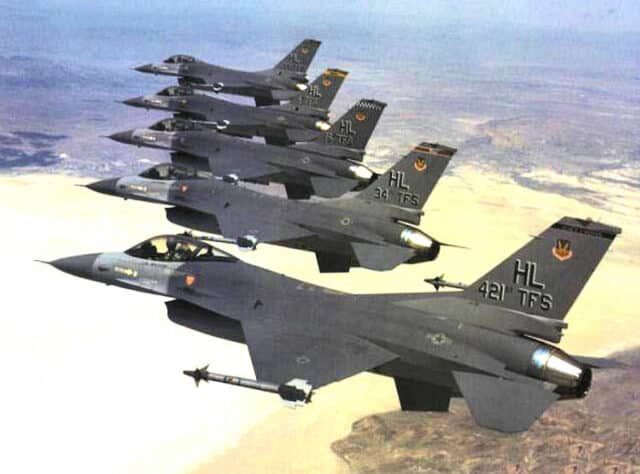
Engines
However, all that doesn’t help you know which aircraft is which if you are on the ground and they are in the air. In this case, you should wait for the jet to pass you and take a look at the exhausts. The dead giveaway is that the F-16 has one engine (a Pratt & Whitney F100-PW-220 engine) and the Typhoon has two (twin EuroJet J200 engines).
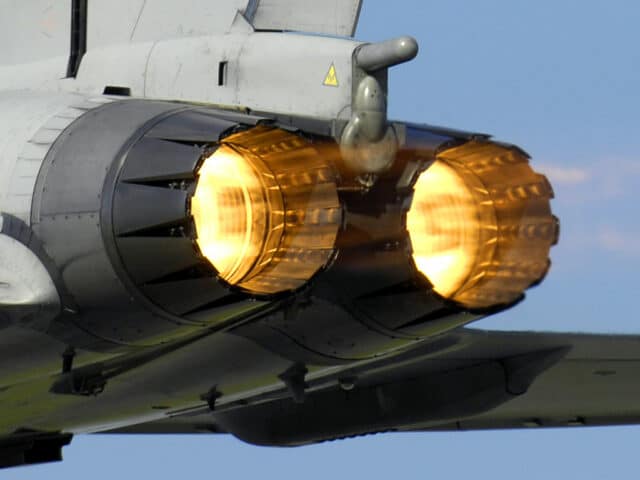
So, if you see two glowing orange circles as it flies away from you, you know it’s a Eurofighter.
If there’s only one, it’s an F-16.
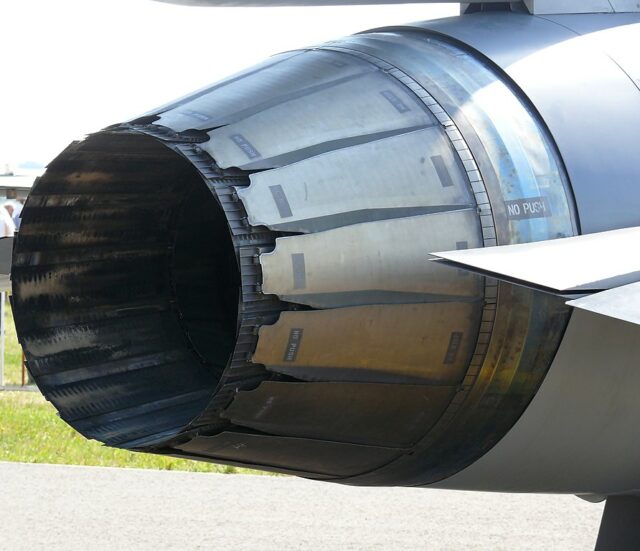
Wings
If the jet is flying straight at you, it is a little bit more difficult. However, the Eurofighter has canards: small forewings forward of the main wing. Canards have been used to add lift and flight control since the Wright Flyer; however, the complex aerodynamics meant that it was another 50 years before it appeared on a mass-produced aircraft, the Saab 37 Viggen. On the Eurofighter, the control canards enhance pitch control and high-alpha performance, making it the stronger dog fighter.

Meanwhile, the F-16 does not have canards (see also, old). Instead, it has what appears to be a cropped wing compared to the Eurofighter. The swept-back wings are diagonal, with the tip of the wing behind the start of the wing. This raises the speed that the F-16 can operate at by delaying the point at which air density affects the aircraft. The result is that the F-16 has better overall performance across the flight envelope.
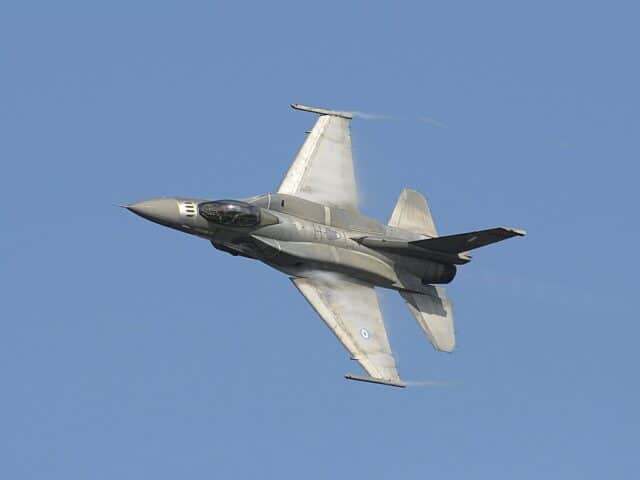
Cockpit
In the unlikely event that you find yourself in the cockpit of an unfamiliar fighter jet that you are expected to fly, don’t panic! The answer is right in front of you: look for the location of the control stick.
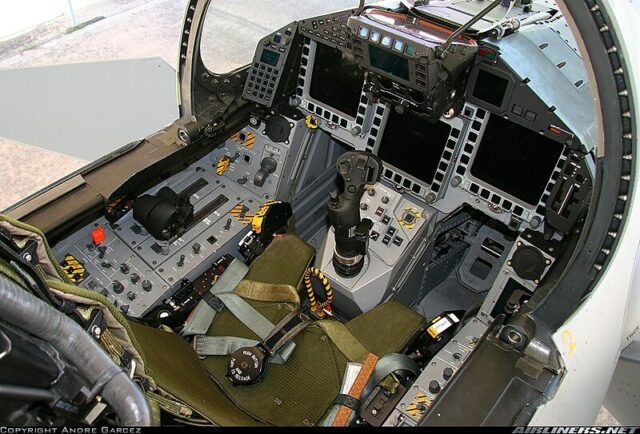
If the stick is nestled snugly between your legs, then congratulations! You are in control of a Eurofighter Typhoon. The centre-mounted stick is part of the Eurofighter’s VTAS (Voice, Throttle and Stick) control system.
If the control stick is mounted on your right armrest and fits in your hand like a melted chocolate bar, then hurray! You are in an F-16 Fighting Falcon. The F-16 was the first aircraft to use a fly-by-wire flight control system and the comfortable reclined seat and side stick controller are meant to increase your control during high-g manoeuvres.
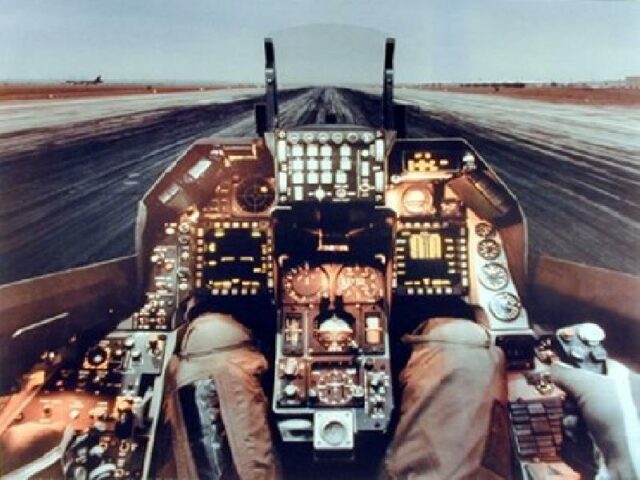
The key is knowing where to look. As long as you can find the control stick, you can tell which cockpit you are in. Now, you just have to work out how to start it.
Tail
One quick trick could be to look at the tail and see if there is a flag on it.
- If the tail has a German flag, you can be sure that it is a Eurofighter EF2000.
- If it has a British flag, it’s exactly the same aircraft but you need to call it the Eurofighter Typhoon.
- If it has a US flag or one of the four NATO partners in the European Participating Governments (Belgium, Denmark, Netherlands, Norway), then it’s an F-16 Fighting Falcon but if you are talking to an enthusiast, you should refer to it as the Viper.
- If it has an Oman flag, it could be either the Eurofighter or the F-16.
- If you don’t recognise the flag, it’s probably the F-16, which has had a much wider range of operators.
- Oh, and if it has a French flag, it’ll be the Dassault Rafale.
So now, if an American pilot, a British pilot and a French pilot walk into the bar arguing which is the best multi-role fighter jet, you can choose a side with confidence! Just don’t line them up for a size comparison.

What if they are in a race?
If the Eurofighter Typhoon and the F-16 Fighting Falcon were in a fair race, then the Eurofighter would win both in speed and, if the race were straight up, in altitude.
| Attribute | EF (Eurofighter) | F-16 |
|---|---|---|
| Speed | 2495 kph | 2120 kph |
| Ceiling | 19810 m | 15240 m |
| Rate of Climb | 62,000 ft/min | 50,000 ft/min |
| Range | 2900 km | 4220 km |
As you can see, the Eurofighter is faster than the F-16, can climb away faster and reach a higher altitude.
However, the Eurofighter will also tire first. In a long-distance endurance race, the F-16 will catch up and, as the Eurofighter falters and falls, the F-16 will continue for another 820 miles (1,320 kilometres). That’s the entire length of the Rhine river.
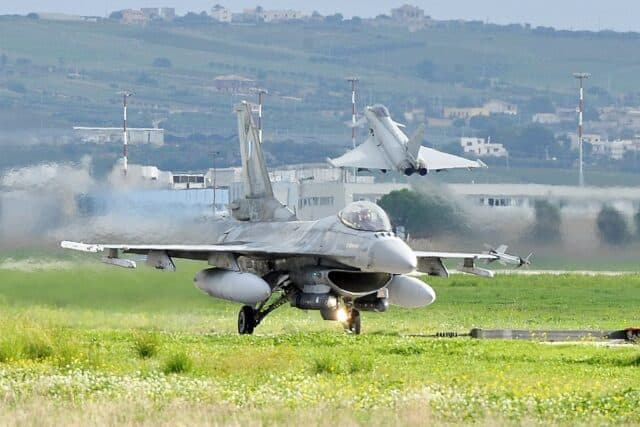
Now that you can tell the difference…
You find yourself in the ultimate high-stakes scenario. You are playing with a Virtual Reality flight simulator when a glitch in the matrix accidentally pulls you into the war game for real. To escape back to your time and place, you’ll have to survive the mission. But you have one last chance: you get to choose your fighter jet: the F-16 or the Eurofighter?
In that split second, which would you pick? The battle-tested, agile F-16 with its impressive range, or the newer, faster, higher-flying Eurofighter?
The good news is, there’s no wrong answer. Each aircraft has its strengths and arguments rage as to which is the more manoeuvrable. The bad news is, that means your escape is riding on the skill and decision-making of the pilot, and you are the only one in the cockpit.
I hope this has been helpful and that the next time you see one of these fighters, you immediately know which one it is.
Just don’t ask me to identify them in photographs. I hear that can be tricky.
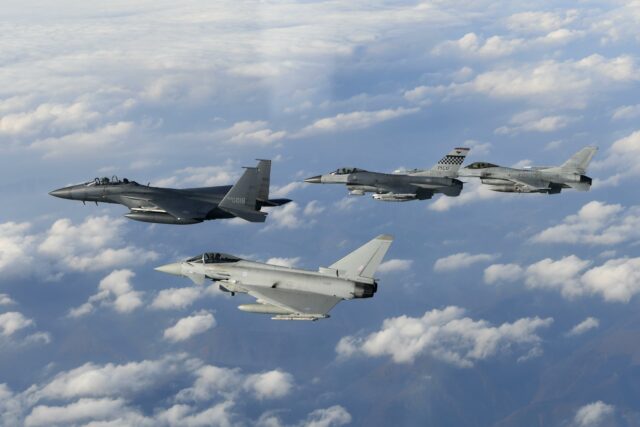








“if it’s only one” it may be a Eurofighter with a failed engine
Oh dammit, now you’ve made it complicated!
“Eurofighter Tycoon”
Sorry, it’s a trivial typo but it made me giggle.
I really, really need an editor to follow me around everywhere!
Thanks for the practical guide for everyday use!
While you’re at it, we might need one for distinguishing A320s and A220s as well, as the airshow article constantly mentioned people flying A320s for Air Baltic or training to fly A320s for Air Baltic and they don’t actually have any of those :-)
Delusions of grandeur, maybe?
I’m going to the other article right now to fix this and we shall never, ever speak of it again.
How about the sound/loudness of it?
I was at an air display maybe 10yo and the eurofighter was really loud. I commented to someone I knew who was involved with it’s development – they said “yeah, it’s a noisy b***r”.
Is the f-16 different? Louder / quieter / different pitch?
I’m at a place where Police, Air ambulances, private helicopters and Chinooks often fly over and can normally tell the difference by the sound before looking. Not when they are all there at the same time… :)
Sorry, replied to the wrong comment…
That’s an interesting question! I’m not sure how often I want to subject myself to F-16/Eurofighter engine roar to test it, though!
Well played, Sylvia!
This actually shows that you’ve got the freelance writer’s killer instinct, which is the ability to look at any situation (including a mildly embarrassing one) and quickly think how it can be turned into a story or article.
Thanks for the vote of confidence! I’m feeling a bit raw around the edges but it has certainly been an adventure!
The only reason why I don’t now believe all three examples of your opening paragraph have happened to you is that you’ve never written about an aircraft-themed escape room…
What a delight to read a great followup to an excellent article!
Hah, yes, and I definitely would have written about it if I’d found one. This is clearly an opportunity waiting for someone to jump on it.
Typhoons made 10 mile away from me. Can hear them take off to practise, nearly always low sky sadly.
Shot down, game over?
Hah, not for the first time.
Another way to tell them apart is to order one of each and look at the bill. The one that cost 3 times as much as the other is probably the Eurofighter.
Ouch!
Sorry Sylvia, wasn’t trying to start something!!!! I do love this post though.
God, no, don’t apologise! Can you imagine if no one told me? I’m glad you enjoyed my penance :)
If it had been modern civilian aircraft I’d have had no clue, but I grew up a USAF brat traveling from one airbase to another lol.